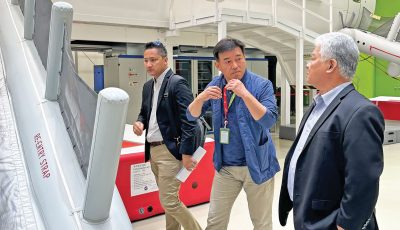Manzhouli

Special to the Saipan Tribune
In my Iloko dialect, suli means a corner. Manzhouli sits on a corner in the northwest promontory of Nei Menggu bordering into Wai Menggu (now the nation of Mongolia) and Russia. It is that part of China that is sandwiched between Mongolia and Russia east of Ulan Batur, and southeast of Irkutzk, in the Hulanbier prefecture.
Getting off the train on midday, the first visual assault was on the seemingly misplaced copulas atop Slavic architecture in the skyscape of this city by the Mongolian grasslands.
Manzhouli is the Russian word for Manchuria, and the city was first built as the entry point of the rail line from Moscow, which later extended to Harbin. It would have gone all the way to Dalian had not the Japanese taken over, but the Mukden to Manzhouli train we took actually originated in Dalian (Darien to history buffs).
Harbin prides itself as the Moscow of the Far East, and its old architecture in the business district justifies its claim to the shadows of Byzantium. But Manzhouli is, for all practical purposes, a modern Russian city, with Zhongguoren proprietors. The commercial signage is in Russian Cyrilic alphabet along with Zhongwen characters. We did not pay close attention to the Byzantine languages back in graduate school and our little foray into Deutsh only got us into the lazy habit of running into the dictionary.
Besides, we had the mistaken notion that to be nationalistic in the Philippines at the time, we had to object to the requirement that we earn 24-credit hours to learn our Spanish to get a Bachelor’s degree. Our rationale was choice rather than imposed DoE requirement, but the consequence was dire. Our familiarity to the tongue of Cervantes became cursory, at best, to our chagrin when we found us in Sud America where the nuances of Castillan, Basque, Aranese, and Catalan were lost to our untrained ear. We were also totally lost in Portuguese Rio de Janeiro.
Language was not our Manzhouli contradiction; billeting was. It was reasonable that on this summer, we headed north rather than go to the humid south. Half of China agreed, and they seemed to have come along. Manzhouli’s cold is not until the end of August.
All the hotels with large Russian names had prices geared toward the international jet set, while the national hotels hosted the Chinese nouveau riche with their preferred GM/Ford sedans and Mercedes Benz/Land Rover SUV’s. For a country of relatively low per capita income, China has sure got a lot of loaded folks!
Luckily, we discovered from the tour guide on the train that at the basement near large hotels, there are sleeping rooms available to tour guides and the transient crowd at very reasonable prices, provided one will share a WC and sleep in windowless rooms. When I located one of these places, I was ready to plunk the $10 per night accommodation rate until I told the young proprietor that I would stay for four nights. Kindly he lowered my rate to only $8. The backpackers’ stop where I was originally headed charge $15 per head in shared quarters, so I really lucked out.
Shower at the communal bathroom is only $2 per soak-and-wash, with an option for dead skin scrubbing at an additional $1. My four-day rate = a hair saloon visit in SF!
Every Chinese town locates around a body of water, either around a lake or along a river, and Manzhouli has Beihu Lake and park where the people gather in the evening. The young boys go into acrobatic break dancing, or do fantastic rapid steps, while elders and matrons with grandkids in tow line dance along familiar Nei Menggu music. At the park, some sell wares on spread blankets, or browse through the instant flea market.
A favorite game is the jian zi where strips from one piece of colorful paper or celluphane is centrally round metal weighted and secured by rubber band, kicked from one person to another (a version of sipa in Pea Eye), involving anywhere from three to a dozen folks. Others sling shot flashing projectiles into the sky, while others fire up paper lanterns billowed like blown shopping bags and sent up as air lanterns
The flashing neon lights are, however, for the shopping. Evening is the time of choice. Multiply Garapan by a factor of 500 and one gets a picture of what downtown Manzhouli looks like, all 10-by-five rectangular blocks of commercial glitter. It is still naturally light at 8pm so the tourists are out buying up the offerings of the numerous 10R-and-up stores. We decided to get scarves that hawked for 20R (renminbi), less than $3 each. I use them as centerpiece covers in my classroom.
Military issued “Made in Russia” (I was assured by the tour guide that anything marketed as “Made in Russia” was surely from Guanzhou) 6×24 magnification binoculars sell for less than $15, though a proprietor showed me the expensive German ones for $400 when he discovered I was a foreigner.
All the Russians I saw were rotund, so I skipped the Russian cuisine. The Mongolian diet of roasted lamb and calf dripped with too much cholesterol, and it shows among Chinese who prefer to keep their wardrobe tight fitting rather than draped.
We were good for Guangdong noodles and vegetable soup. That’s a corner already turned.
****
Jaime R. Vergara (jrvergarajr2031@aol.com) is a former PSS teacher and is currently writing from the campus of Shenyang Aerospace University in China.



























